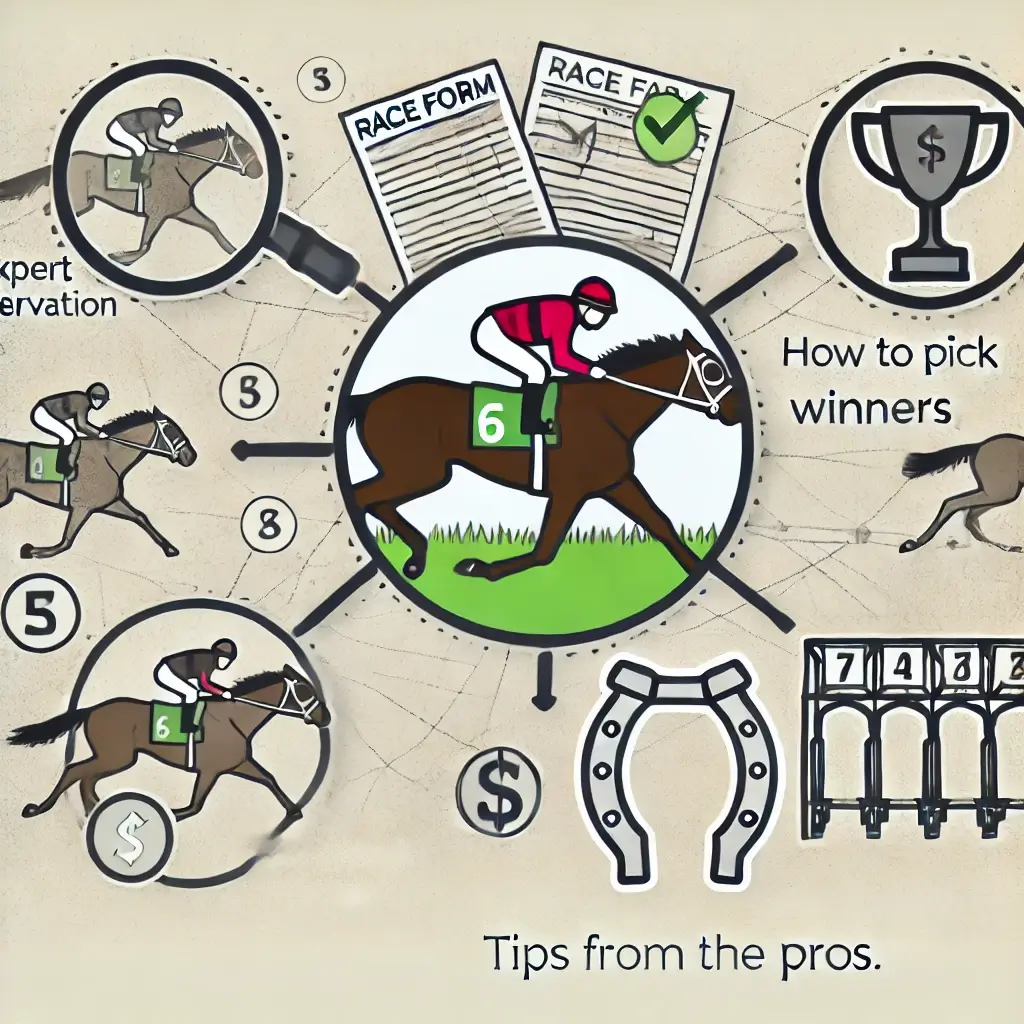How to Pick Winners in Horse Racing: Tips from the Pros
Whether you're a casual bettor or aspiring to be a professional tipster, picking winners in horse racing is both an art and a science. This comprehensive guide will walk you through the essentials, advanced strategies, and insider tips to help you boost your success rate at the track.

Understanding the Fundamentals
Before we dive into advanced strategies, let's ensure you have a solid grasp of the key factors that influence a horse race:
1. Form
A horse's recent performance history is crucial. Look for:
- Consistency in finishing positions
- Improvement trends
- Performance in similar race conditions
Pro Tip: Don't just look at finishing positions. A horse that finished 4th in a high-class race might be more impressive than a winner in a lower-class event.
2. Class
Class in horse racing refers to the level of competition. Consider:
- Is the horse moving up or down in class?
- How has it performed against similar competition?
Example: A horse that consistently finishes mid-pack in Group 1 races might dominate in a Group 3 race.
3. Track Conditions
Different horses excel in different conditions. Pay attention to:
- Track surface (turf, dirt, synthetic)
- Going (firm, good, soft, heavy)
Quick Stat: Some horses show up to 20% improvement in their preferred conditions.
4. Jockey and Trainer
The human element is crucial. Consider:
- Jockey's win percentage at the track
- Trainer's success rate with similar types of horses
Insider Tip: Look for successful jockey-trainer combinations. Some pairs have exceptional chemistry that leads to consistent wins.
5. Distance and Pace
Every horse has its preferred running style and optimal distance. Analyze:
- Horse's past performances at the race distance
- Likely pace scenario of the race
Pro Insight: A fast pace typically favors closers, while a slow pace benefits front-runners.
Strategies for Picking Winners: From Beginner to Advanced
Beginner Strategies
-
Follow Top Jockeys and Trainers
- Start by backing horses ridden by leading jockeys or trained by top trainers.
- Example: At Royal Ascot, Ryan Moore's mounts often outperform their odds due to his skill and connections.
-
Use Expert Ratings
- Utilize ratings from respected sources like Timeform or Racing Post.
- Tip: Look for horses rated significantly higher than their competitors.
-
Consider Recent Form
- Horses in good form often maintain it.
- Rule of Thumb: Horses with two or more top-three finishes in their last three races are often solid bets.
Intermediate Strategies
-
Analyze Speed Figures
- Compare speed figures of the horses in the race.
- Pro Tip: Look for horses with consistent figures rather than one standout performance.
-
Track Bias Awareness
- Some tracks favor certain running styles or post positions.
- Example: At Ascot, high draws often have an advantage in sprint races on the straight course.
-
Value Betting
- Look for horses whose odds are higher than their actual chances of winning.
- Calculation: If you think a horse has a 25% chance of winning (true odds of 3/1), but it's offered at 5/1, that's value.
Advanced Strategies
-
Pace Analysis
- Predict how the race will unfold based on the running styles of the participants.
- Tool: Use pace maps or speed graphs to visualize the likely race shape.
-
Pedigree Analysis for Specific Conditions
- Some bloodlines excel in certain conditions (e.g., soft ground, long distances).
- Example: Offspring of Galileo often improve significantly when stepped up in distance.
-
Sectional Timing
- Analyze split times to identify horses that finished strongly despite slow early fractions.
- Pro Insight: A horse closing fast in a slowly-run race might be primed for a big performance next time out.
-
Betting Market Analysis
- Track significant market moves, especially for lesser-known connections.
- Rule: A substantial price drop (e.g., 10/1 to 5/1) close to the race often indicates strong stable confidence.
Advanced Case Study: Dissecting a Race
Let's apply these strategies to a hypothetical race:
Newmarket 3:30 PM - Group 1 Lockinge Stakes (1 mile, Turf)
-
Timeform Top-Rated (130)
- Pros: Highest rated, consistent Group 1 performer
- Cons: Coming off a layoff, prefers softer ground
-
Improving 4yo (TR 125)
- Pros: Progressive profile, won last 3 starts, handles the track
- Cons: First time in Group 1 company
-
Speedy Front-Runner (TR 127)
- Pros: Likely to set the pace, could steal the race
- Cons: Distance might be a stretch, vulnerable late
-
Classic Winner (TR 128)
- Pros: Proven class, excels at the distance
- Cons: Inconsistent recent form
-
International Raider (TR 129)
- Pros: Top-class form abroad, handles firm ground
- Cons: First time at the track, travel concerns
Analysis:
- Pace Scenario: Likely to be steadily run with Speedy Front-Runner setting the tempo
- Track Condition: Good to Firm (standard for Newmarket)
- Key Factors: Class, current form, and ability to handle Newmarket's unique undulations
Pro's Pick: Improving 4yo
- Rationale: Progressive profile suggests there's more to come, proven at the track, and the steady pace should suit their running style. The step up in class is a concern, but at likely odds of 6/1, it represents value against more established but possibly vulnerable rivals.
Betting Strategy:
- Win bet on Improving 4yo
- Exacta box: Improving 4yo, Timeform Top-Rated, and Classic Winner
- Small each-way play on International Raider as a hedge against the unknown quality
Common Pitfalls and How to Avoid Them
-
Overreliance on Favorites
- Pitfall: Blindly backing favorites leads to long-term losses.
- Solution: Look for value bets where the odds exceed the actual probability of winning.
-
Ignoring Track Characteristics
- Pitfall: Applying the same criteria to all tracks.
- Solution: Study track-specific trends and biases.
-
Emotional Betting
- Pitfall: Trying to recoup losses with bigger bets or sticking with a horse despite poor value.
- Solution: Stick to a pre-defined staking plan and always prioritize value.
-
Lack of Specialization
- Pitfall: Trying to bet on every race.
- Solution: Focus on specific types of races or tracks where you have the most knowledge and success.
Conclusion: The Path to Consistent Success
Picking winners in horse racing consistently requires a blend of knowledge, analysis, and disciplined betting practices. Start with the basics, gradually incorporate advanced strategies, and always be willing to learn and adapt. Remember, even the pros don't win every bet – the key is to find value and make profitable decisions over the long term.
More Betting Guides
Fundamentals of Horse Racing Betting
- Bankroll Management for Horse Racing: Tips to Stay Profitable
- Horse Racing Betting 101: A Beginner’s Guide to Understanding Bets, Racing Forms, and More
- Understanding Odds: How to Maximize Your Winnings
Betting Strategies
- Each-Way Betting: A Safer Approach to Horse Racing Bets
- How to Pick Winners in Horse Racing: Tips from the Pros
- Value Betting in Horse Racing: How to Identify and Capitalize on Undervalued Horses
Advanced Betting Techniques
- Mastering Exacta Betting: From Beginner to Pro
- Mastering Multi-Race Bets: Strategies for Pick 3, Pick 4, Pick 5, and Pick 6 in Horse Racing
- Trifecta and Superfecta Betting: Strategies for Big Payouts
Analysis and Prediction
- How to Analyze Past Performance to Predict Future Success
- Jockey and Trainer Analysis: How to Factor Human Elements into Your Bets
- The Impact of Track Conditions and Biases: How to Adjust Your Bets
Specialized Knowledge
More of our latest tips & picks
💎 Value Tips Finder
Discover horses with high tipster consensus but generous odds

Great Britain
Tuesday
Tuesday

Ireland

United States
Monday
Monday
Monday
Monday

South Africa
Tuesday
🏇 Upcoming Races
See the most-tipped horses for races just around the corner.

Thorough Brett
"Being able to see what other tipsters are picking is fantastic. I love how you can quickly spot trending horses and get a feel for where the smart money is going. The popular picks feature is super useful."


